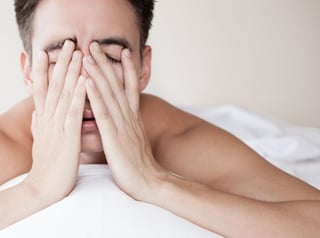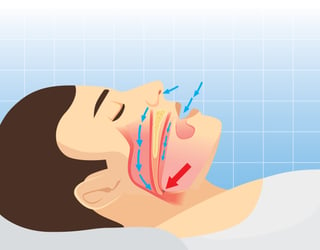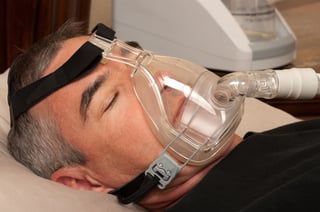
Sleep disorders have become a notable health issue in the United States with an estimated 40 million people suffering from chronic long-term sleep disorders every year, according to the National Institute of Neurological Disorders and Stroke. They also reported that an additional 20 million people experience sleeping problems occasionally.
Sleep apnea, which is a sleeping disorder, is estimated to affect 22 million Americans,  with 80 percent of the cases of moderate to severe obstructive sleep apnea undiagnosed.
with 80 percent of the cases of moderate to severe obstructive sleep apnea undiagnosed.
Sleep apnea is a sleeping disorder in which you have one or more pauses in breathing, or shallow breaths while you are sleeping. The disorder results in decreased oxygen in the blood and can briefly awaken sleepers during the night. Breathing pauses can last for a few seconds or even minutes, and may occur 30 times or even more within an hour. Usually, after a breathing pause, you then start breathing normally sometimes with a choking sound or a loud snort.
This condition can be mild, moderate or severe. The stage or severity is determined by the number of times your breathing stops (apnea), or becomes quite shallow (hypopnea) within a period of an hour. This number can range from 5 to 100 times an hour. If your breathing stops more than 5 times an hour, it is considered to be abnormal. If it stops more than 30 to 40 times per hour it falls under severe sleep apnea.
What Causes Sleep Apnea?
In adults, one of the most common causes is obesity and excess weight. This is associated with the soft tissue of the mouth and throat which causes the airway to become blocked during sleep when throat and tongue muscles are relaxed. When these muscles relax, your airways are either narrowed or blocked, causing you to be unable to breathe air freely in an out of your lungs. Your brain then senses your inability to breathe and rouses you from sleep, to allow you reopen your airway.
The period you wake up is usually so brief that you don’t recall it. This pattern can repeat itself 5 to 30 times or more every hour within the night, and the disruptions impair your ability to get the much needed rest when you are sleeping, causing you to feel sleepy during your waking hours. People with sleep apnea may not know that their sleep was disrupted throughout the night, and may in fact think that they slept soundly.
Other factors that may increase your risk of sleep apnea include;
- Your Family History
- Gender, Males are Twice as Likely to Develop Sleep Apnea
- Being Older
- Smoking
- Nasal Congestion
- Obesity
In children, causes may include;
- Enlarged Tonsils
- Enlarged Adenoids
- Birth Defects Such as Pierre-Robin syndrome or Down syndrome
Childhood obesity is much less commonly associated with sleep apnea compared to adult obesity.
Can Sleep Apnea be Cured? While there are treatments like continuous positive airway pressure ( CPAP) and oral appliances that work extremely great with sleep apnea, these are not cures for the disorder. If you want to get rid of the condition completely, the solution would be to either lose weight or have the excess tissue from the throat or palate removed though surgery. There are however a number of side effects if you choose to do surgery and this is why it is usually looked at as the last resort.
While there are treatments like continuous positive airway pressure ( CPAP) and oral appliances that work extremely great with sleep apnea, these are not cures for the disorder. If you want to get rid of the condition completely, the solution would be to either lose weight or have the excess tissue from the throat or palate removed though surgery. There are however a number of side effects if you choose to do surgery and this is why it is usually looked at as the last resort.
Management of Sleep Apnea
There are several ways to manage sleep apnea and among the factors that contribute to sleep apnea, there are some that can be controlled by lifestyle choices. Following the guidelines below may not only help some people in reducing the effects of sleep apnea, but also reduce their daytime sleepiness by improving the quality of their sleep and ensuring they get the rest they need.
sleep apnea, there are some that can be controlled by lifestyle choices. Following the guidelines below may not only help some people in reducing the effects of sleep apnea, but also reduce their daytime sleepiness by improving the quality of their sleep and ensuring they get the rest they need.
- Avoid alcohol or Drugs that relax the central nervous system – you should avoid alcohol because it relaxes the central nervous system causing the muscles of the throat to relax. It also worsens sleepiness and promotes weight gain exacerbating sleep apnea. Medicines such as sleeping pills or sedatives should also be avoided. Make sure you speak to your doctor before you change or stop taking any medication prescribed to you.
- Weight loss – excess weight is the most common contributor to sleep apnea. Losing weight will help to reduce the severity of your sleep apnea as well as reap other health benefits. This may however be particularly difficult, especially since a poor night’s sleep may induce cravings for high calorie food, and also contribute to low energy levels making it hard to exercise. Eating healthy also contributes to weight loss, making it important to eat a well-balanced diet to help you achieve your weight loss goals. The reduction of extra fat and tissue around the neck reduces pressure on the airway and the tongue and hence managing sleep apnea.
- Quit smoking – smoking can lead to inflammation, making it hard for you to breathe. It also acts as a sedative which is not good for those diagnosed with sleep apnea. When you quit smoking, it will not only help you breathe better, but reduce the severity of your sleeping apnea. It also improves many other health conditions that are usually made worse by smoking.
- Sleeping position – in a diagnostic sleep study, it was observed that in some patients diagnosed with sleep apnea, the severity of the conditioned developed or worsened when sleeping in the supine position. Sleeping in a sleepchair in a non-supine position may correct or improve apnea in some patients but should not be generally relied on as the sole therapy to help manage the condition.
- Concomitant medication – anyone who prescribes medication to a patient with sleep apnea should be informed of the condition that the patient has. This is because there are some medications which have inhibitory effects on the central nervous system and should be avoided if there is a reasonable alternative that exists. Benzodiazepines, in particular, should not be prescribed to patients with sleep apnea, especially those that are untreated. This is because this drug may exacerbate sleep apnea and also cause daytime sleepiness. Antidepressants that cause weight gain may also be problematic in these patients. In cases where the medications are felt to be necessary despite the patient’s condition, the dose should be carefully titrated if possible and the patient should be closely monitored.
- Patient education – where a patient has been diagnosed and the severity of their sleep apnea has been determined, the doctor should sit down with the patient and educate them about their disorder. The patient should be educated about natural history, risk factors and the consequences of sleep apnea. Most importantly, the patient should be warned about the increased risk of motor vehicle accidents associated with sleep apnea and also the consequences of operating heavy machinery or equipment while feeling sleepy. Patients should be advised to avoid activities that require alertness and vigilance when feeling sleepy.
If these measures do not improve the development or symptoms of your sleep apnea, a number of other treatments are available. These are usually used for patients with moderate to severe sleep apnea and they include;

- Continuous positive airway pressure (CPAP) – this is a machine that delivers air pressure through a mask placed over your nose while you sleep. The air pressure is just enough to keep your upper passages open since it is somewhat greater than that of the surrounding air, preventing snoring and apnea. Even though CPAP is a reliable method, many find it uncomfortable and may opt to use a different airway pressure device for example; Auto-CPAP, bi-level positive airway pressure (BiPAP) or expiratory positive airway pressure (EPAP). If your mask feels uncomfortable, or the pressure feels too strong, talk to your doctor so that some adjustments can be made.
- Oral appliances – this is another option which is designed to keep your throat open. Although it is less reliably effective than CPAP, it may be easier to use. Some are designed to open your throat by bringing your jaw forward, which helps relieve sleep apnea and snoring.
- Surgery – This is usually the last resort, and is the go-to option after all the other treatment options have failed. However, for those with certain structure problems with their jaw, it is usually a good option to start with. Surgical options may include the following;
- Jaw repositioning – where your jaw is moved forward from the remainder of your face bones. It is also known as maxillomandibular advancement.
- Tissue removal – which is called uvulopalatopharyngoplasty, where the surgeon removes tissue from the rear side of your mouth and the top of your throat.
- Implants – where plastic rods are surgically implanted into the soft palate after receiving local anesthetic.
- Tracheostomy – where your surgeon makes an opening into your neck and inserts a plastic or metal tube which you use for breathing. You keep the top covered during the day and only uncover it during the night to allow air pass into and out of the lungs, bypassing the blocked air passage in your throat. This form of surgery is required if you have severe life-threatening sleep apnea.
- Other forms of surgery may include weight loss surgery to reduce excess fat and tissue, nasal surgery or surgery to remove enlarged tonsils or adenoids.
Along with these treatments, you may see or hear about other forms of treatment for sleep apnea or other ways to manage the disorder on the television, through a friend or through any other medium of advertisement. You are however advised to first talk to your doctor about any treatment before you take it up.



